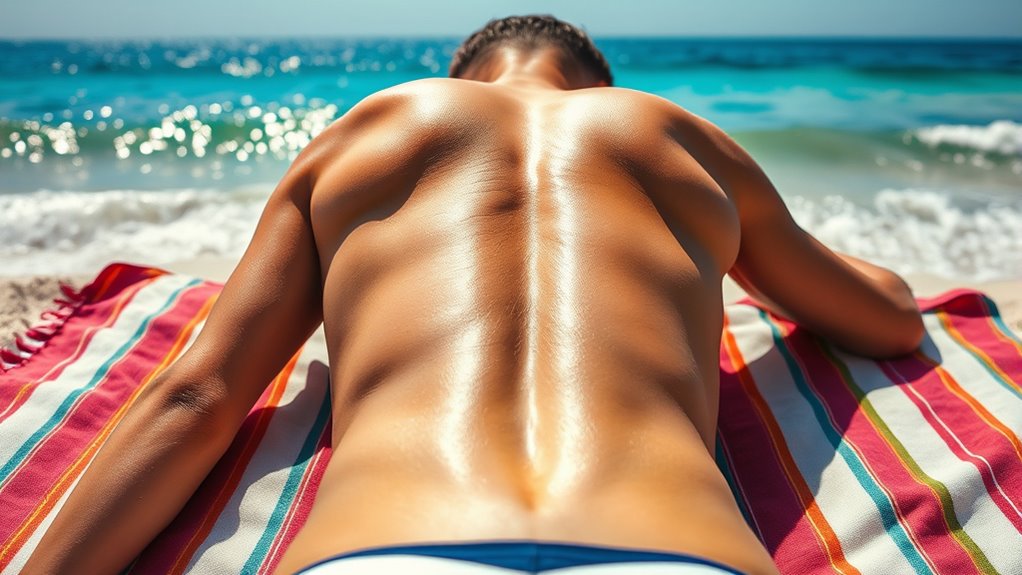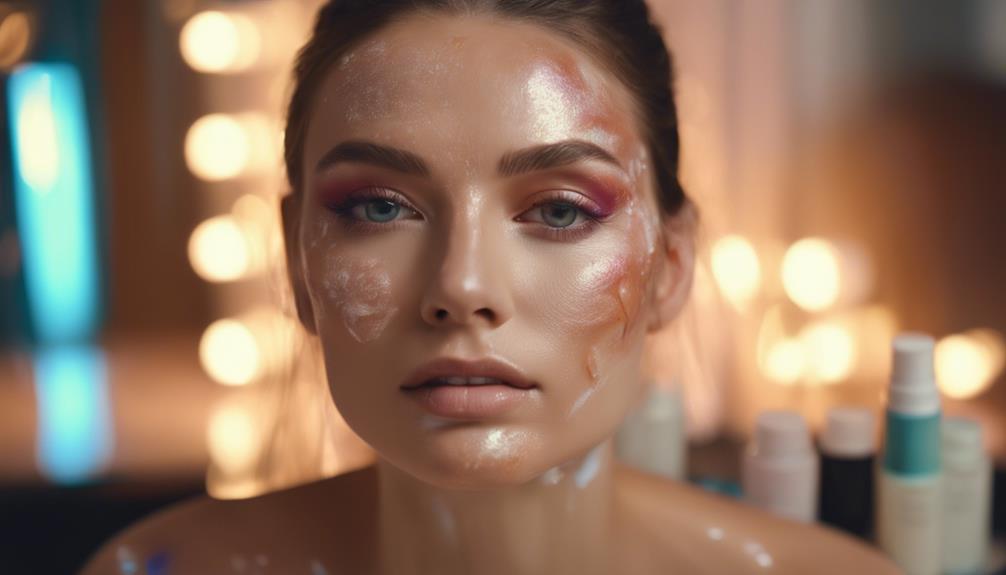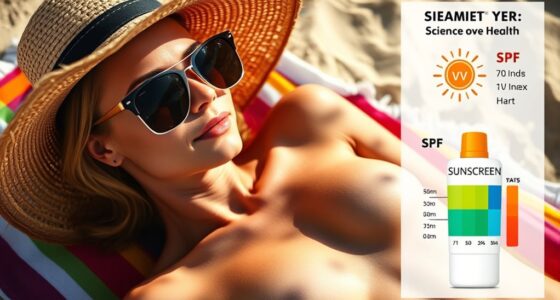A base tan offers only minimal sun protection, roughly SPF 2-4, which is far below recommended levels. Relying on it can give you a false sense of security, leading to more sun damage, premature aging, and higher skin cancer risk. Tanning beds can worsen skin harm and increase cancer chances. Safer options like self-tanners and proper sun protection are much better. Keep exploring to learn how you can protect your skin effectively and avoid false safety.
Key Takeaways
- A base tan provides minimal SPF 3-4 protection and does not significantly prevent UV damage or skin cancer risk.
- Relying on a tan falsely suggests safety and can lead to increased sun exposure and skin harm.
- Tanning beds and natural sun exposure cause skin aging, DNA damage, and significantly raise skin cancer risks.
- Safer alternatives include self-tanners, spray tans, and protective clothing combined with broad-spectrum sunscreen.
- True sun protection involves limiting UV exposure, wearing protective gear, and applying high-SPF sunscreen, not tanning.
Understanding What a Base Tan Really Is

A base tan is a gradual process where your skin develops a light layer of pigmentation through controlled UV exposure. It involves melanin production, which darkens your skin slightly and offers minimal natural protection against sunburn. Typically, you can develop a base tan after 3 to 5 tanning sessions spaced out to allow your skin to recover. These sessions are carefully managed to reduce burning risk while increasing melanin levels. Think of it as building a protective coating on your skin cells, making them more resistant to UV damage. This process is done under controlled conditions, often indoors, to keep exposure safe. Remember, while a base tan offers some benefit, it’s not a foolproof shield, and sun protection should still be part of your routine. Additionally, some people consider using electric bikes as an eco-friendly way to enjoy outdoor activities, emphasizing sustainable practices alongside sun safety. Understanding UV exposure and its effects can help you make more informed choices about your skin health and overall wellbeing. Being aware of skin cancer risks associated with UV exposure underscores the importance of proper sun protection measures.
The SPF Equivalent of a Base Tan Explained
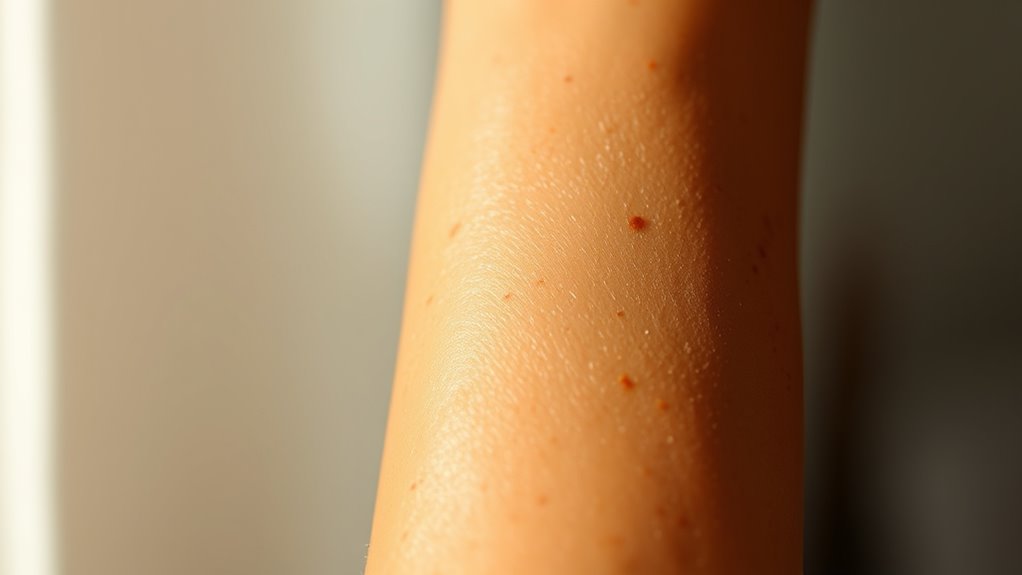
Understanding the sun protection provided by a base tan helps you gauge its effectiveness. Most experts estimate that a base tan offers an SPF equivalent between 2 and 5, usually around 3 to 4. This means your skin can tolerate about 3 to 4 times more UV exposure before burning compared to untanned skin. For example, if untanned skin burns after 10-20 minutes, a base tan might extend this to 30-80 minutes, depending on individual factors. However, this SPF level is very low compared to the recommended SPF 15 to 30 for adequate protection. Tanning beds, which mainly produce UVA rays, offer even less, roughly SPF 1.5, providing minimal protection and giving a false sense of security. Recognizing that a base tan may not provide sufficient protection highlights the importance of proper sun safety measures. Additionally, relying solely on a base tan can lead to increased skin damage over time, emphasizing that sun safety practices are essential regardless of tanning status. Moreover, understanding the limitations of a base tan is crucial in making informed decisions about sun exposure and protection.
A new sentence to add:
It’s important to remember that even a light tan is a sign of skin damage and does not replace sunscreen or other protective measures.
The Risks of Relying on a Base Tan for Protection
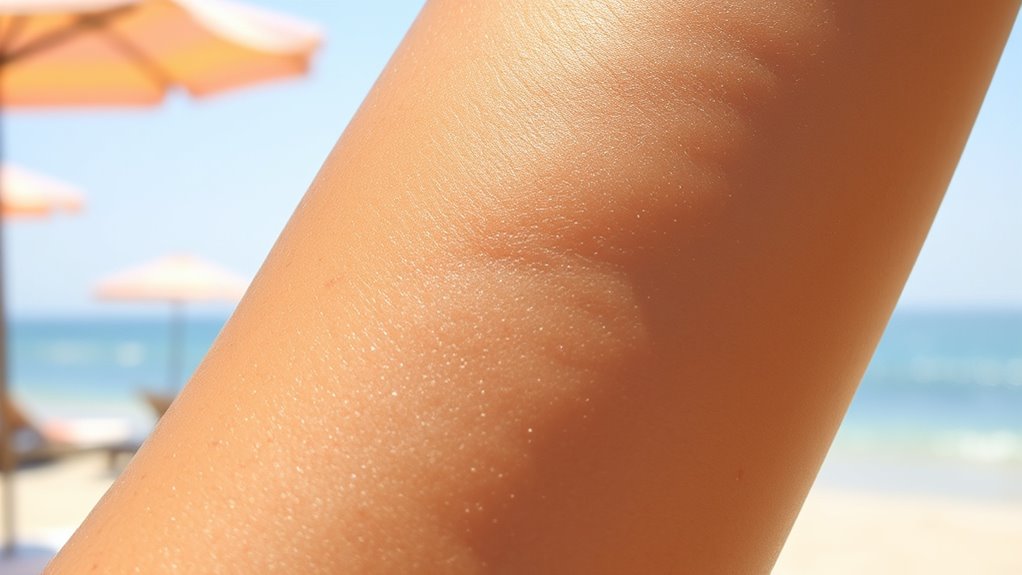
Relying on a base tan for protection can be misleading because it offers only minimal defense against harmful UV rays. A base tan has an SPF of just 3 to 4, meaning it allows about four times more sun exposure before burning compared to untanned skin. This is far below the SPF 15 to 30 recommended for effective protection. Importantly, a tan doesn’t block enough UVB rays that cause redness and DNA damage. It may give a false sense of security, leading you to spend more time in the sun without proper protection. This increases your risk of sunburn, skin damage, and premature aging. Relying on a base tan is risky and doesn’t prevent the cumulative damage that can lead to skin cancer over time. Additionally, a tan provides no reliable sun protection, emphasizing the need for sunscreen and other protective measures.
How Tanning Beds Contribute to Skin Damage and Cancer Risks

Tanning beds expose your skin to concentrated UV radiation, which markedly increases your risk of developing skin cancer. Using indoor tanning raises the chances of squamous cell carcinoma by 58% and basal cell carcinoma by 24%. If you start tanning before age 20, your melanoma risk jumps by 47%, and the more you tan, the higher the risk. Even four sessions a year can boost your chances of squamous cell carcinoma by 15% and melanoma by 11%. Early exposure during high school or college significantly raises basal cell carcinoma risk. Studies show that nearly all women diagnosed with melanoma before 30 had used tanning beds. These risks highlight that indoor tanning is a major factor contributing to the rise in skin cancer rates worldwide. Incorporating UV exposure from tanning beds into your lifestyle dramatically increases the likelihood of developing serious skin conditions. As the automation of tanning devices advances, the potential for uncontrolled UV exposure rises, further heightening health risks. Moreover, the decline in public awareness about these dangers has led many to underestimate the long-term consequences of indoor tanning. Additionally, genetic mutations such as BRCA1 and BRCA2 can further increase individual susceptibility to skin cancers caused by UV damage.
The Limitations of a Base Tan Against UVA and UVB Rays
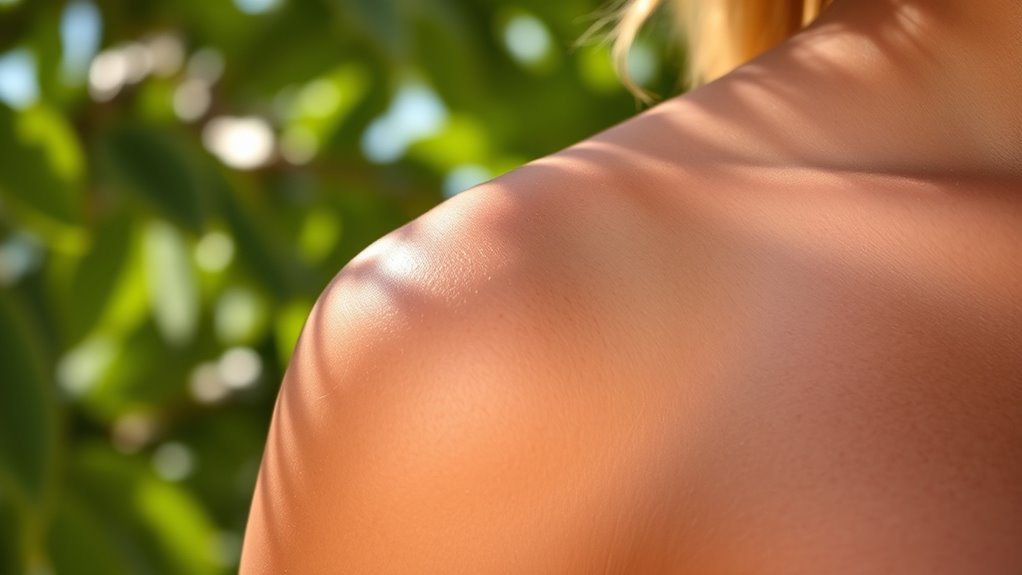
A base tan may seem like a harmless way to prepare your skin for sun exposure, but it offers limited protection against the full spectrum of UV radiation. While it’s true that a tan indicates increased melanin production, it provides only a minimal SPF of about 3 to 4. Key components of sound design, such as sound effects and ambient sounds, are essential in creating immersive environments, but they do not replace proper sun protection. UVA rays penetrate deeply, causing skin aging and DNA damage, yet a base tan offers little defense—roughly SPF 2 or 3 at best. UVB rays, responsible for sunburn, can still damage your skin despite a tan, increasing cancer risk. Relying on a base tan is risky; it gives you a false sense of security. Better protection comes from broad-spectrum sunscreens, protective clothing, and avoiding prolonged sun exposure altogether. Your skin’s health depends on effective UV defense, not a superficial tan. Sun safety practices are essential for minimizing skin damage and long-term health risks. Additionally, a tan does not significantly alter the skin’s ability to protect against UV rays; natural skin pigmentation remains limited in its protective capacity. Moreover, understanding the limitations of a base tan is crucial for realistic sun safety expectations. Recognizing that sunscreen efficacy varies based on application and reapplication is key to effective protection.
Why a Base Tan Is Not a Safe or Effective Sun Shield
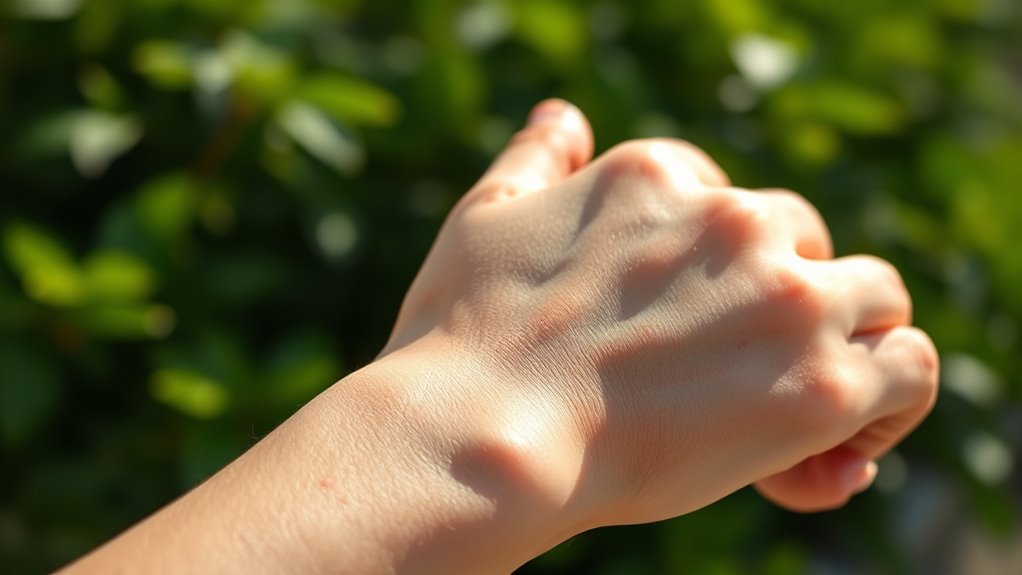
A base tan may give the appearance of added protection, but in reality, it offers very limited defense against harmful UV rays. It provides an SPF of about 3 to 4, far below the minimum SPF 15 recommended for effective protection. This means your skin can still be exposed to nearly four times more UV radiation before burning, and even less if you have a salon base tan, which might offer below SPF 1. Relying on a base tan instead of sunscreen is unsafe, as it doesn’t prevent sunburn or UV damage. It contributes to cumulative skin damage and increases your risk of skin cancer. Many falsely believe a base tan shields them, leading to longer sun exposure and neglect of proper sun protection measures. Natural Language Processing (NLP) advancements also facilitate better public awareness by analyzing sentiment and providing targeted education about sun safety. Understanding long-term skin health underscores that no tan can replace protective measures like sunscreen and clothing. Additionally, a tanning response is the skin’s way of signaling damage, not protection, emphasizing that a tan is a sign of harm rather than safety. Recognizing the importance of skin protection strategies can help prevent unnecessary skin damage over time.
The Impact of Tanning on Skin Aging and DNA Damage
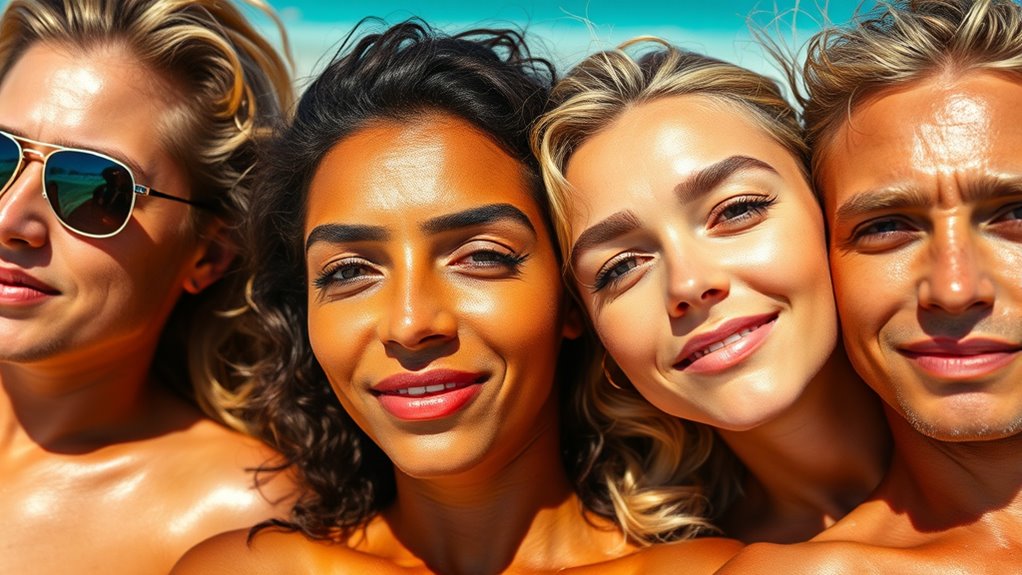
Indoor tanning exposes your skin to up to 15 times more UV radiation than natural sunlight, dramatically accelerating the aging process. This intense exposure causes wrinkles, leathery skin, and brown age spots—signs of photoaging that develop much earlier. Both UVA and UVB rays break down collagen and reduce skin elasticity, leading to premature loss of firmness. Repeated UV exposure damages skin cells, triggering inflammation and degrading proteins like elastin and collagen, which speeds up aging. Tanned skin shows visible signs of aging years before untanned skin. Additionally, UV radiation causes direct DNA damage, creating mutations that accumulate over time. This damage increases your risk of skin cancer, including melanoma. No level of artificial UV exposure is safe or prevents the aging process. Cookies used to enhance browsing experience can also collect data related to your online behavior, which may influence personalized content and advertisements.
Safer Alternatives to Achieve a Tanned Look
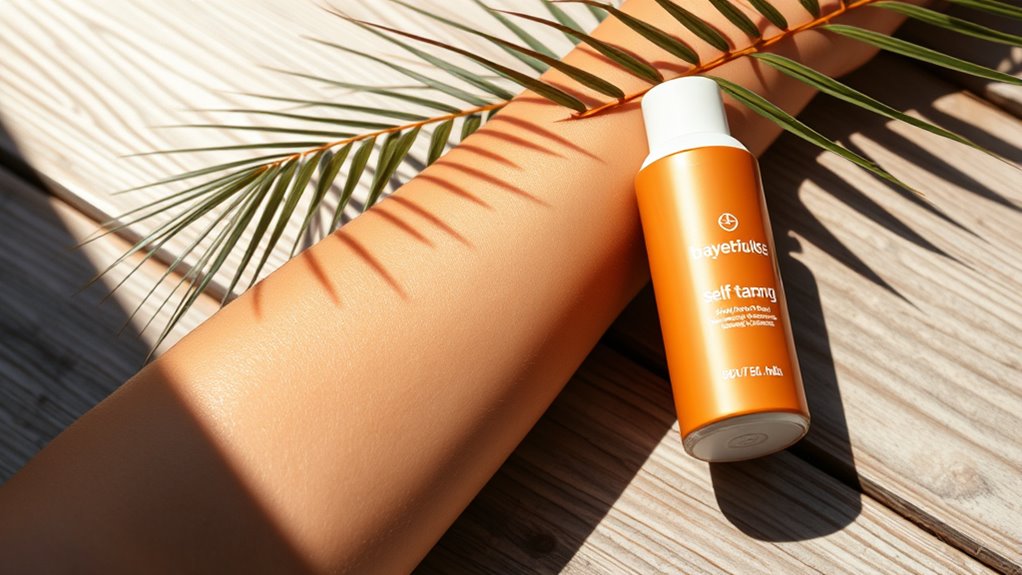
If you want a sun-kissed glow without risking skin damage, there are several safer options to contemplate. Self-tanning products, like lotions, gels, and sprays, contain dihydroxyacetone (DHA), which reacts with skin amino acids to create a temporary tan without UV exposure. Gradual tanning lotions build color slowly while hydrating your skin for a natural look. Spray tans, administered professionally, offer a flawless, long-lasting result in a single session—just exfoliate beforehand and moisturize afterward for best longevity. Bronzing products like powders, oils, and creams provide instant, washable color for special occasions or daily use. These alternatives allow you to enjoy a bronzed appearance without the harmful effects of UV rays or tanning beds. Additionally, preppy dog names are a fun way to personalize your pet’s identity with a touch of style.
Using sunscreen with broad-spectrum protection remains essential when spending time outdoors, even if you’re using these safer tanning options.
Proven Sun Protection Strategies for All Skin Types

Protecting your skin from UV damage involves more than just choosing a tanning alternative; it requires a thorough approach tailored to all skin types. Start by applying a broad-spectrum sunscreen with at least SPF 30, covering UVA and UVB rays. Apply it generously 30 minutes before sun exposure, and reapply every two hours or more often if you’re swimming or sweating. Wear protective clothing like long sleeves, wide-brimmed hats, and UV-blocking sunglasses to shield sensitive areas. Seek shade during peak hours between 10 a.m. and 4 p.m., and be mindful of UV index forecasts. For sensitive or infant skin, use mineral-based sunscreens and protective clothing, avoiding direct sun exposure. Combining these strategies guarantees effective protection for everyone, regardless of skin type.
Expert Recommendations for Reducing UV Exposure

Limiting your UV exposure during peak hours is essential for maintaining healthy skin. Avoid outdoor activities between 10 AM and 4 PM when UV rays are strongest. Schedule outdoor chores, like mowing or gardening, early in the morning or late in the afternoon. Seek shade under trees, umbrellas, or portable sunshades during peak hours. Remember, UV rays can reflect off surfaces and reach your skin even in shade, so additional protection is necessary. Wear protective clothing, such as long-sleeved shirts and wide-brimmed hats made from UPF-rated fabrics, to block UV rays. Use UV-blocking sunglasses to protect your eyes. Reapply broad-spectrum sunscreen every two hours, especially during prolonged outdoor time. Combining shade, clothing, and sunscreen offers the best defense against harmful UV exposure.
Frequently Asked Questions
Can a Base Tan Prevent Sunburns Effectively?
A base tan can’t prevent sunburns effectively. While it offers some minimal protection—roughly SPF 3 to 4—it’s far below the recommended SPF 15 or higher. Relying on a tan to shield your skin is risky because it still allows significant UV damage. To truly prevent sunburns, you should regularly apply broad-spectrum sunscreen, wear protective clothing, and seek shade during peak sunlight hours.
Is It Safe to Develop a Base Tan From Tanning Beds?
Thinking about developing a base tan from tanning beds? Don’t be fooled—it’s not safe. While it might seem like a quick way to get some color, the risks are serious. Tanning beds ramp up your chances of skin cancer, accelerate skin aging, and cause DNA damage with every session. There’s no such thing as a safe tan from these devices. Protect your skin—avoid tanning beds altogether.
Does a Tan Provide Any Protection Against UVA Rays?
A tan doesn’t offer reliable protection against UVA rays. While it produces more melanin, the SPF from a tan is only about 2 to 4, which isn’t enough to prevent UVA damage. UVA rays penetrate deep, causing skin aging, DNA damage, and increasing cancer risk. To protect yourself, always use broad-spectrum sunscreen with at least SPF 30, wear protective clothing, and seek shade during peak sun hours.
How Much Does a Base Tan Reduce the Risk of Skin Cancer?
A base tan doesn’t substantially reduce your skin cancer risk. It provides only minimal protection, equivalent to SPF 2-4, far below the recommended SPF 30 or higher. Relying on a tan gives you a false sense of security, but UV damage still accumulates, increasing mutation risk. To truly protect yourself, use broad-spectrum sunscreen, wear protective clothing, and avoid excessive sun exposure, especially during peak hours.
Are There Any Health Benefits to Having a Base Tan?
You might think a base tan offers health benefits like improved appearance or mood, but the truth is, these are mostly misconceptions. While it may seem to boost confidence or energy, a base tan barely offers any real protection—equivalent to SPF 3-4—and still exposes you to damaging UV rays. Safer options like self-tanning products and protective clothing provide the same benefits without risking skin damage or cancer.
Conclusion
Don’t rely on a base tan to protect your skin. Imagine spending a summer day at the beach, thinking your tan shields you from damage—only to find out it’s like wearing a weak armor. Instead, choose safer options like sunscreen, protective clothing, and shade. Protecting your skin now prevents premature aging and serious health risks later. Your skin’s health is worth the effort—so make smart choices and enjoy the sun safely.
